Optimisation Investigation and Bond-Slip Behaviour of High Strength PVA-Engineered Geopolymer Composite (EGC) Cured in Ambient Temperatures
Abstract
:1. Introduction
2. Experimental
2.1. Materials and Specimen Preparation
2.2. Mix Design Preparation
3. Results and Discussion
3.1. Response Surface Methodology Analysis
3.1.1. Analysis of Variance (ANOVA) of the Response Model
3.1.2. Optimisation
3.1.3. Experimental Validation
3.2. Mix Design of EGC and GPC
3.3. Fresh Property of EGC
Flow Table Test
3.4. Mechanical Properties of EGC and GPC
3.5. Bond Behaviour
3.5.1. Bond Strength
3.5.2. Bond Failure Modes
3.5.3. Bond Stress Slip Curves
3.5.4. Factors Affecting Bond Strength of EGC
4. Conclusions
- Optimisation was performed using the optimum values of 25% for GGBS and 0.4 for the alkaline solution to fly ash ratio, which achieved a desirability of 93% in ANOVA. Triplicate experiments were conducted to validate the optimum conditions. The predicted and experimental values of the compressive strength in this study were 57.092 MPa and 58.235 MPa, respectively. The error between the predicted and experimental results was less than 5%.
- The highest compressive strength that was achieved by the EGC specimen on 28 days is 60 MPa with silica fume replacement of 20%. Moreover, it was able to obtain the highest workability.
- EGC reached higher early strength on day 1 with a value of 12.58 MPa compared to GPC, which only produces 5 MPa in ambient curing without the need of heat curing due to the absence of GGBS in the GPC matrix. The presence of GGBS in EGC is able to provide internal heating in EGC matrix, which reduces the curing time and enhances the early strength of EGC. Meanwhile, the compressive strength of EGC and GPC at 28 days were produced to be similar to ensure accuracy of the results during the comparison of mechanical properties, such as tensile strength and flexural strength.
- EGC demonstrated approximately 9% higher flexural strength and 150% higher tensile strength compared to GPC. Moreover, EGC exhibited higher ductility, as evidenced by the presence of multiple cracks before failure in tension and flexure, whereas GPC specimens exhibited no fine cracks before failure. The presence of PVA fibres in the EGC matrix enhanced the bridging effect in the beams, indicating that EGC is more ductile with good strain hardening properties.
- The average bond strength of EGC was observed to be higher than that of GPC for both embedment length and rebar diameter parameters.
- According to the results, it was noticed that, as the embedment length of rebar increases, the bond strength of EGC decreases. This is mainly due to the increases in the non-uniform transfer of bond stress along the rebar. Other than that, the bond strength of EGC rises with the increase in rebar diameter. The increase in rebar diameter influences the relative bond area between the rebar and concrete which indirectly influence the bond behaviour and bond strength of EGC.
- Based on the failure modes, it has been denoted that EGC specimens exhibit ductile failure modes by failing in pull-out or pull-out splitting failure, while GPC specimens fails in brittle nature by failing in splitting mode.
- Based on the bond stress–slip curve, which is influenced by the bond failure modes, it could be denoted that EGC specimen produces better bonding strength compared to GPC specimen. This is supported by the pattern of the stress–slip curve in the descending branch of EGC which has a steady and gradual decrease rather than a sudden drop which can be observed in the descending branch of GPC specimen.
Author Contributions
Funding
Data Availability Statement
Acknowledgments
Conflicts of Interest
References
- Zhang, Z.; Provis, J.L.; Reid, A.; Wang, H. Geopolymer foam concrete: An emerging material for sustainable construction. Constr. Build. Mater. 2014, 56, 113–127. [Google Scholar] [CrossRef]
- Asghar, R.; Khan, M.A.; Alyousef, R.; Javed, M.F.; Ali, M. Promoting the green Construction: Scientometric review on the mechanical and structural performance of geopolymer concrete. Constr. Build. Mater. 2023, 368, 130502. [Google Scholar] [CrossRef]
- Zahid, M.; Shafiq, N. Effects of Sand/Fly Ash and the Water/Solid Ratio on the Mechanical Properties of Engineered Geopolymer Com-posite and Mix Design Optimization. Minerals 2020, 10, 333. [Google Scholar] [CrossRef]
- Nath, P.; Sarker, P.K. Effect of GGBFS on setting, workability and early strength properties of fly ash geopolymer concrete cured in ambient condition. Constr. Build. Mater. 2014, 66, 163–171. [Google Scholar] [CrossRef]
- Luhar, I.; Luhar, S. A Comprehensive Review on Fly Ash-Based Geopolymer. J. Compos. Sci. 2022, 6, 219. [Google Scholar] [CrossRef]
- Al-Majidi, M.H.; Lampropoulos, A.; Cundy, A.; Meikle, S. Development of geopolymer mortar under ambient temperature for in situ applications. Constr. Build. Mater. 2016, 120, 198–211. [Google Scholar] [CrossRef]
- Adak, D.; Sarkar, M.; Mandal, S. Effect of nano-silica on strength and durability of fly ash based geopolymer mortar. Constr. Build. Mater. 2014, 70, 453–459. [Google Scholar] [CrossRef]
- Afroughsabet, V.; Ozbakkaloglu, T. Mechanical and durability properties of high-strength concrete containing steel and polypropylene fibers. Constr. Build. Mater. 2015, 94, 73–82. [Google Scholar] [CrossRef]
- Ohno, M.; Li, V.C. A feasibility study of strain hardening fiber reinforced fly ash-based geopolymer composites. Constr. Build. Mater. 2014, 57, 163–168. [Google Scholar] [CrossRef]
- Zhang, N.; Yan, C.; Li, L.; Khan, M. Assessment of fiber factor for the fracture toughness of polyethylene fiber reinforced geopolymer. Constr. Build. Mater. 2022, 319, 1–18. [Google Scholar]
- Ganesan, N.; Abraham, R.; Deepa Raj, S. Durability characteristics of steel fibre reinforced geopolymer concrete. Constr. Build. Mater. 2015, 93, 471–476. [Google Scholar] [CrossRef]
- Abbas, A.-G.N.; Abdul Aziz, F.N.A.; Abdan, K.; Nasir, N.A.M.; Huseien, G.F. Experimental evaluation and statistical modeling of kenaf fiber-reinforced geopolymer concrete. Constr. Build. Mater. 2023, 367, 130228. [Google Scholar] [CrossRef]
- Liu, Y.; Zhang, Z.; Shi, C.; Zhu, D.; Li, N.; Deng, Y. Development of ultra-high performance geopolymer concrete (UHPGC): Influence of steel fiber on mechanical properties. Cem. Concr. Compos. 2020, 112, 103670. [Google Scholar] [CrossRef]
- Humur, G.; Cevik, A. Effects of hybrid fibers and nanosilica on mechanical and durability properties of lightweight engineered geopoly-mer composites subjected to cyclic loading and heating–cooling cycles. Constr. Build. Mater. 2022, 326, 126846. [Google Scholar] [CrossRef]
- Xu, S.; Malik, M.A.; Qi, Z.; Huang, B.; Li, Q.; Sarkar, M. Influence of the PVA fibers and SiO2 NPs on the structural of fly ash based sustainable geopolymer. Constr. Build. Mater. 2018, 164, 238–245. [Google Scholar] [CrossRef]
- Zhang, P.; Wei, S.; Wu, J.; Zhang, Y.; Zheng, Y. Investigation of mechanical properties of PVA fiber-reinforced cementitious composites under the coupling effect of wet-thermal and chloride salt environment. Case Stud. Constr. Mater. 2022, 17, e01325. [Google Scholar] [CrossRef]
- Cai, J.; Pan, J.; Han, J.; Wang, X. Mechanical Behaviors of Metakaolin-Based Engineered Geopolymer Composite under Ambient Curing Condition. J. Mater. Civ. Eng. 2022, 34, 04022152-1–04022152-12. [Google Scholar] [CrossRef]
- Alraeeini, A.S.; Nikbakht, E. Corrosion effect on the flexural behaviour of concrete filled steel tubulars with single and double skins using engineered cementitious composite. Structures 2022, 44, 1680–1694. [Google Scholar] [CrossRef]
- Al-Majidi, M.H.; Lampropoulos, A.; Cundy, A.B. Tensile properties of a novel fibre reinforced geopolymer composite with enhanced strain hardening characteristics. Compos. Struct. 2017, 168, 402–427. [Google Scholar] [CrossRef]
- Abbas, A.-G.N.; Abdul Aziz, F.N.A.; Abdan, K.; Nasir, N.A.M.; Huseien, G.F. A state-of-the-art review on fibre-reinforced geo-polymer composites. Constr. Build. Mater. 2022, 330, 127187. [Google Scholar] [CrossRef]
- Attaurrehman; Khan, A.; Hasnain, M. A Review of Structural Performance of Geopolymer Concrete. Glob. Sci. J. 2019, 7, 447–455. [Google Scholar]
- Law, D.W.; Adam, A.A.; Molyneaux, T.K.; Patnaikuni, I.; Wardhono, A. Long term durability properties of class F fly ash geopolymer concrete. Mater. Struct. 2015, 48, 721–731. [Google Scholar] [CrossRef]
- Shaikh, F. Deflection hardening behaviour of short fibre reinforced fly ash based geopolymer composites. Mater. Des. 2013, 50, 674–682. [Google Scholar] [CrossRef]
- Bernal, S.; Gutierrez, R.D.; Delvasto, S.; Rodriguez, E. Performance of an alkali-activated slag concrete reinforced with steel fibers. Constr. Build. Mater. 2010, 24, 208–214. [Google Scholar] [CrossRef]
- ASTM C618; Standard Specification for Coal Fly Ash and Raw or Calcined Natural Pozzolan for Use as a Mineral Admixture in Concrete. ASTM International: West Conshohocken, PA, USA, 2001.
- ASTM C1437-15; Standard Test Method for Flow of Hydraulic Cement Mortar. ASTM International: West Conshohocken, PA, USA, 2015.
- BS 1881-116:1983; Method for Determination of Compressive Strength of Concrete Cubes. British Standards Institution: London, UK, 1983.
- BS 1881-117:1983; Method for Determination of Tensile Splitting Strength. British Standards Institution: Pilsen, Czech Republic, 1983.
- ASTM D3039; Standard Test Method for Tensile Properties of Polymer Matrix Composite Materials. ASTM International: West Conshohocken, PA, USA, 2017.
- ASTM D5045-14; Standard Test Methods for Plane-Strain Fracture Toughness and Strain Energy Release Rate of Plastic Materials. ASTM International: West Conshohocken, PA, USA, 2014.
- ASTM C234-91a; Standard Test Method for Comparing Concretes on the Basis of the Bond Developed with Reinforcing Steel (Withdrawn 2000). ASTM International: West Conshohocken, PA, USA, 1991.
- Rafiza, A.; Zarina, Y.; Al Bakri, A.M.; Subaer, S.; Khairunnisa, M.; Wazien, A.W.; Teng, T. Effect of Ground Granulated Blast Slag (GGBS) to the Bonding Strength of Geopolymer Mortar as Repairing Material. J. Adv. Manuf. Technol. (JAMT) 2020, 14, 57–64. [Google Scholar]
- Fauzi, A.; Nuruddin, M.F.; Malkawi, A.B.; Abdullah, M.M.A.B.; Mohammed, B.S. Effect of Alkaline Solution to Fly Ash Ratio on Geopolymer Mortar Properties. Cem. Concr. Compos. 2017, 733, 85–88. [Google Scholar] [CrossRef]
- BS 1881-125:1986; Testing Concrete Methods for Mixing and Sampling Fresh Concrete in the Laboratory. British Standards Institution: London, UK, 2013.
- Abdulkadir, I.; Mohammed, B. RSM analysis and study on the 6 months compressive strength development and shrinkage behaviour of high volume fly ashrubberized ecc (hvfa-recc). Int. J. Adv. Res. Eng. Technol. 2020, 11, 965–980. [Google Scholar]
- Rahim, N.I.; Mohammed, B.S.; Abdulkadir, I.; Dahim, M. Effect of Crumb Rubber, Fly Ash, and Nanosilica on the Properties of Self-Compacting Concrete Using Response Surface Methodology. Materials 2022, 15, 1501. [Google Scholar] [CrossRef]
- Zhang, L.; Yue, Y. Influence of waste glass powder usage on the properties of alkali-activated slag mortars based on response surface methodology. Constr. Build. Mater. 2018, 181, 527–534. [Google Scholar] [CrossRef]
- Appana, P.M.; Mohammed, B.S.; Abdulkadir, I.; Ali, M.A.; Liew, M. Mechanical, Microstructural and Drying Shrinkage Properties of NaOH-Pretreated Crumb Rubber Concrete: RSM-Based Modeling and Optimization. Materials 2022, 15, 2588. [Google Scholar] [CrossRef]
- ASTM C1437-01; Standard Test Method for Flow of Hydraulic Cement Mortar. ASTM International: West Conshohocken, PA, USA, 2015.
- Shaikh, F.U.A. Tensile and flexural behaviour of recycled polyethylene terephthalate (PET) fibre reinforced geopolymer composites. Constr. Build. Mater. 2020, 245, 118438. [Google Scholar] [CrossRef]
- Zahid, M.; Shafiq, N.; Razak, S.N.A.; Tufail, R.F. Investigating the effects of NaOH molarity and the geometry of PVA fibers on the post-cracking and the fracture behavior of engineered geopolymer composite. Constr. Build. Mater. 2020, 265, 120295. [Google Scholar] [CrossRef]
- Deepa Raj, S.; Bhoopesh, J. Strength and behaviour of recycled aggregate geopolymer concrete beams. Adv. Concr. Constr. 2017, 5, 145–154. [Google Scholar] [CrossRef]
- Saranya, P.; Nagarajan, P.; Shashikala, A. Behaviour of GGBS-dolomite geopolymer concrete beam-column joints under monotonic loading. Structures 2020, 25, 47–55. [Google Scholar] [CrossRef]
- Cai, J.; Pan, J.; Han, J.; Lin, Y.; Sheng, Z. Impact behaviours of engineered geopolymer composite exposed to elevated temperatures. Constr. Build. Mater. 2021, 312, 125421. [Google Scholar] [CrossRef]
- Deng, M.; Pan, J.; Sun, H. Bond behavior of steel bar embedded in Engineered Cementitious Composites under pullout load. Constr. Build. Mater. 2018, 168, 705–714. [Google Scholar] [CrossRef]
- Yoo, D.-Y.; Shin, H.-O. Bond performance of steel rebar embedded in 80–180 MPa ultra-high-strength concrete. Cem. Concr. Compos. 2018, 93, 206–217. [Google Scholar] [CrossRef]
- Rahman, S.K.; Al-Ameri, R. Experimental Investigation and Artificial Neural Network Based Prediction of Bond Strength in Self-Compacting Geopolymer Concrete Reinforced with Basalt FRP Bars. Appl. Sci. 2021, 11, 4889. [Google Scholar] [CrossRef]
- Xiao, J.; Long, X.; Ye, M.; Jiang, H.; Liu, L.; Zhai, K. Experimental Study of Bond Behavior Between Rebar and PVA-Engineered Cementitious Composite (ECC) Using Pull-Out Tests. Front. Mater. 2021, 8, 633404. [Google Scholar] [CrossRef]
- Cong, X.; Zhou, W.; Elchalakani, M. Bond performance of reinforced alkali-activated composites using water-quenched slag as alternative fine aggregates. Structures 2020, 24, 137–150. [Google Scholar] [CrossRef]
- Solyom, S.; Benedetti, M.D.; Guadagnini, M.; Balazs, G.L. Effect of temperature on the bond behaviour of GFRP bars in concrete. Compos. Part B Eng. 2020, 183, 107602. [Google Scholar] [CrossRef]
- Tekle, B.H.; Khennane, A.; Kayali, O. Bond Properties of Sand-Coated GFRP Bars with Fly Ash–Based Geopolymer Concrete. J. Compos. Constr. 2016, 20, 04016025. [Google Scholar] [CrossRef]
- Shin, H.-O.; Lee, S.-J.; Yoo, D.-Y. Bond Behavior of Pretensioned Strand Embedded in Ultra-High Performance Fiber-Reinforced Concrete. Int. J. Concr. Struct. Mater. 2018, 12, 34. [Google Scholar] [CrossRef]
- Paswan, R.; Rahman, M.R.; Singh, S.; Singh, B. Bond Behavior of Reinforcing Steel Bar and Geopolymer Concrete. J. Mater. Civ. Eng. 2020, 32, 04020167. [Google Scholar] [CrossRef]
- Nurwidayati, R.; Ekaputri, J.; Triwulan; Suprobo, P. Bond Behaviour between Reinforcing Bars and Geopolymer Concrete By Using Pull-out Test. MATEC Web Conf. 2019, 280, 04008. [Google Scholar] [CrossRef]



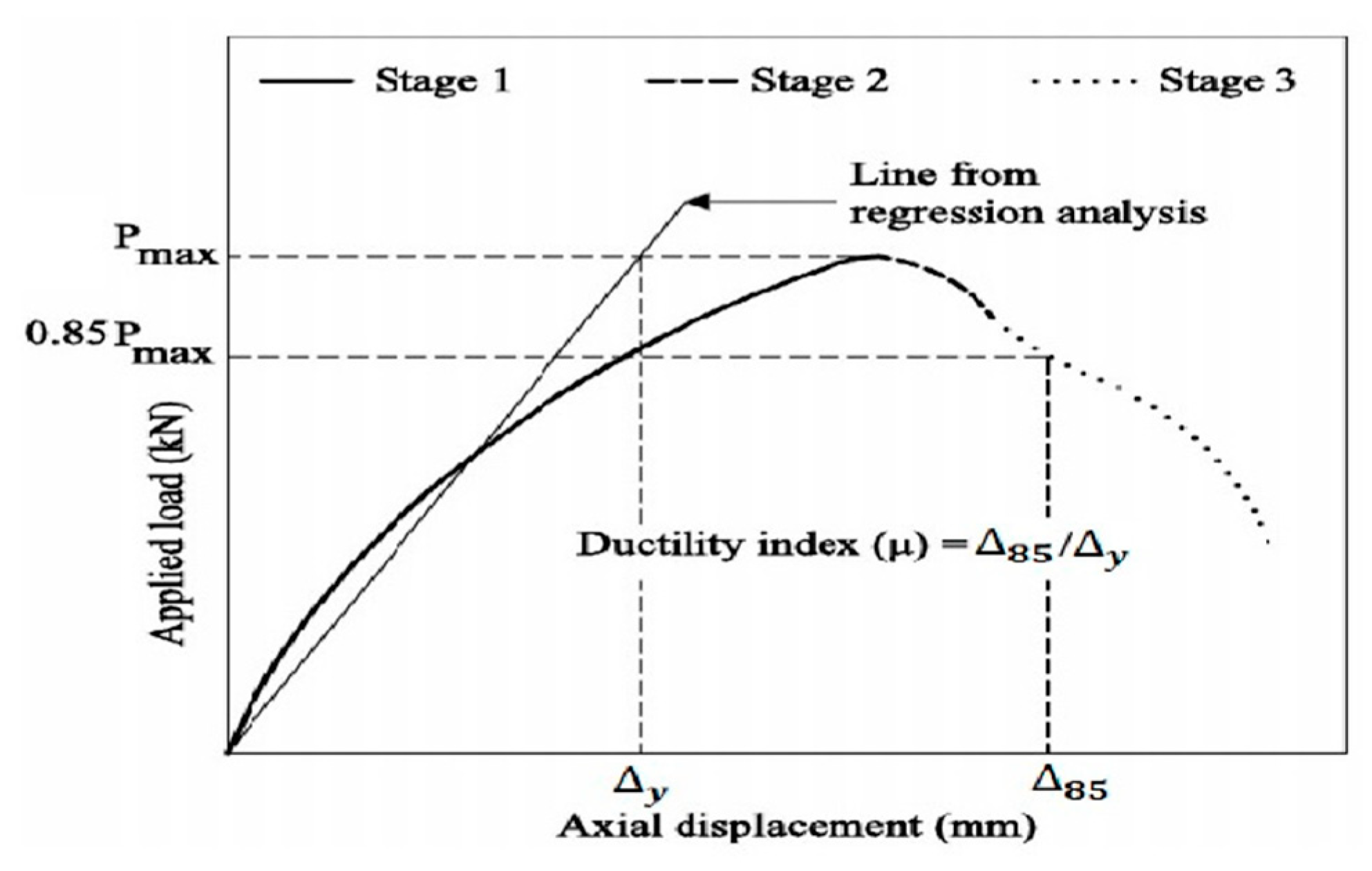
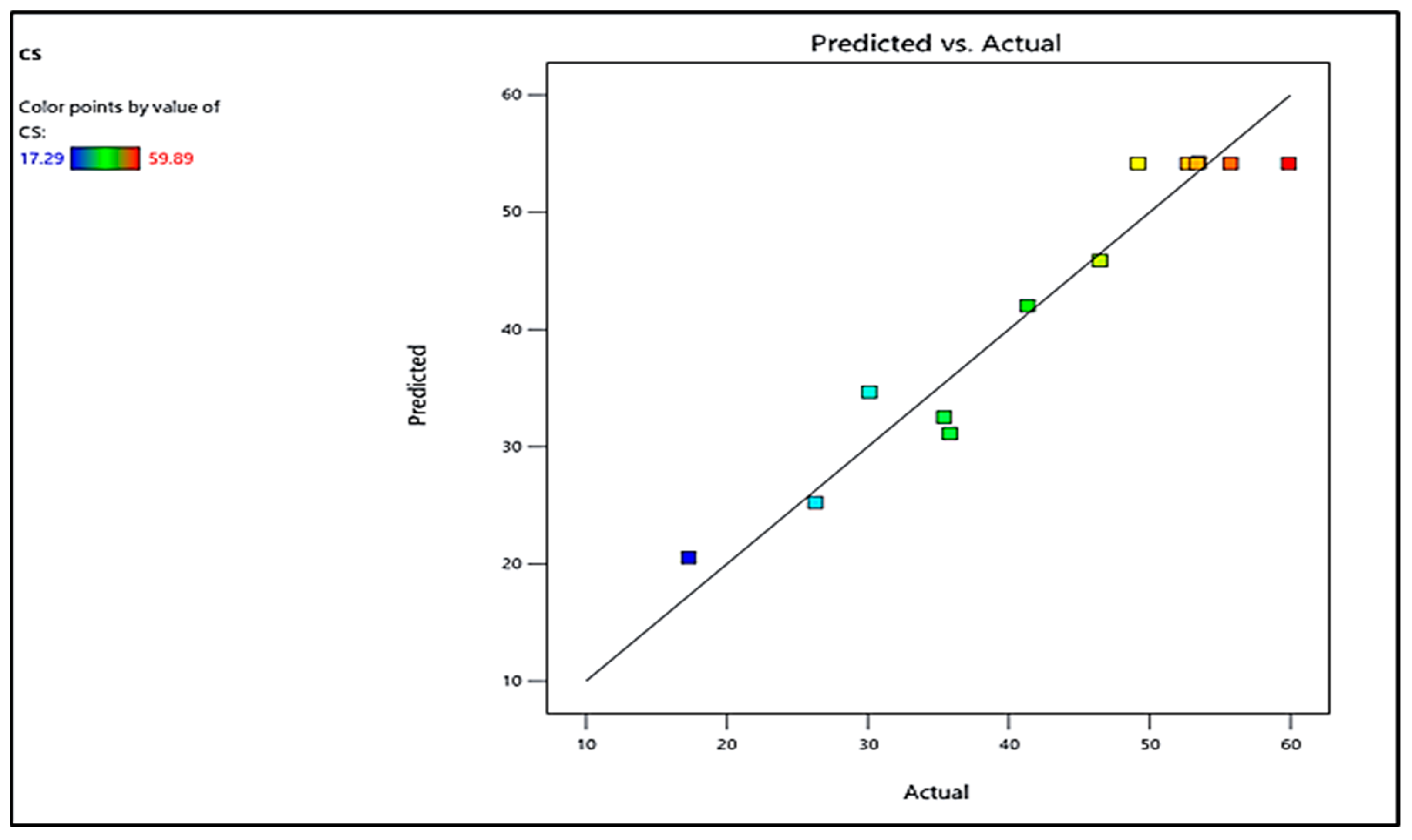


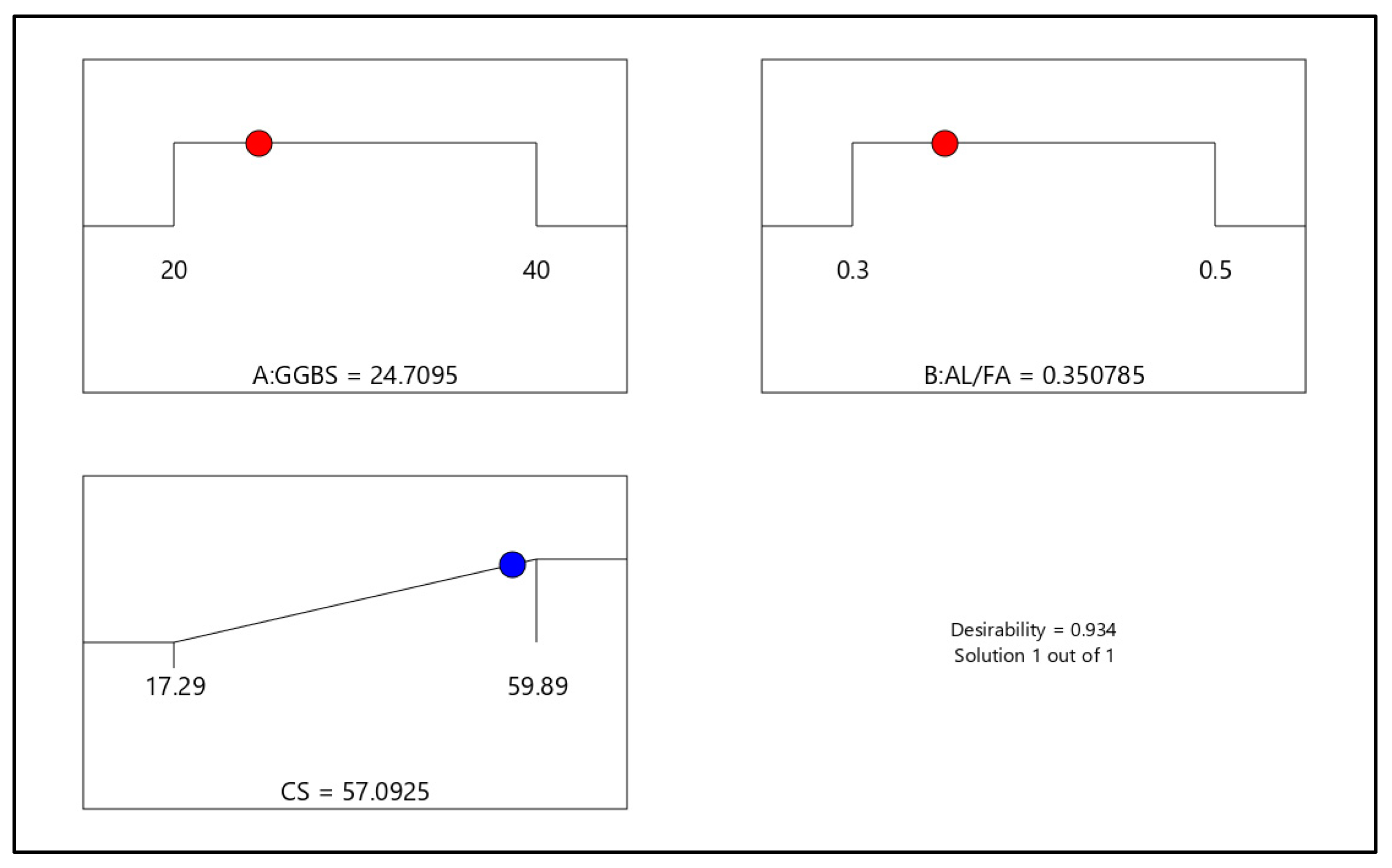
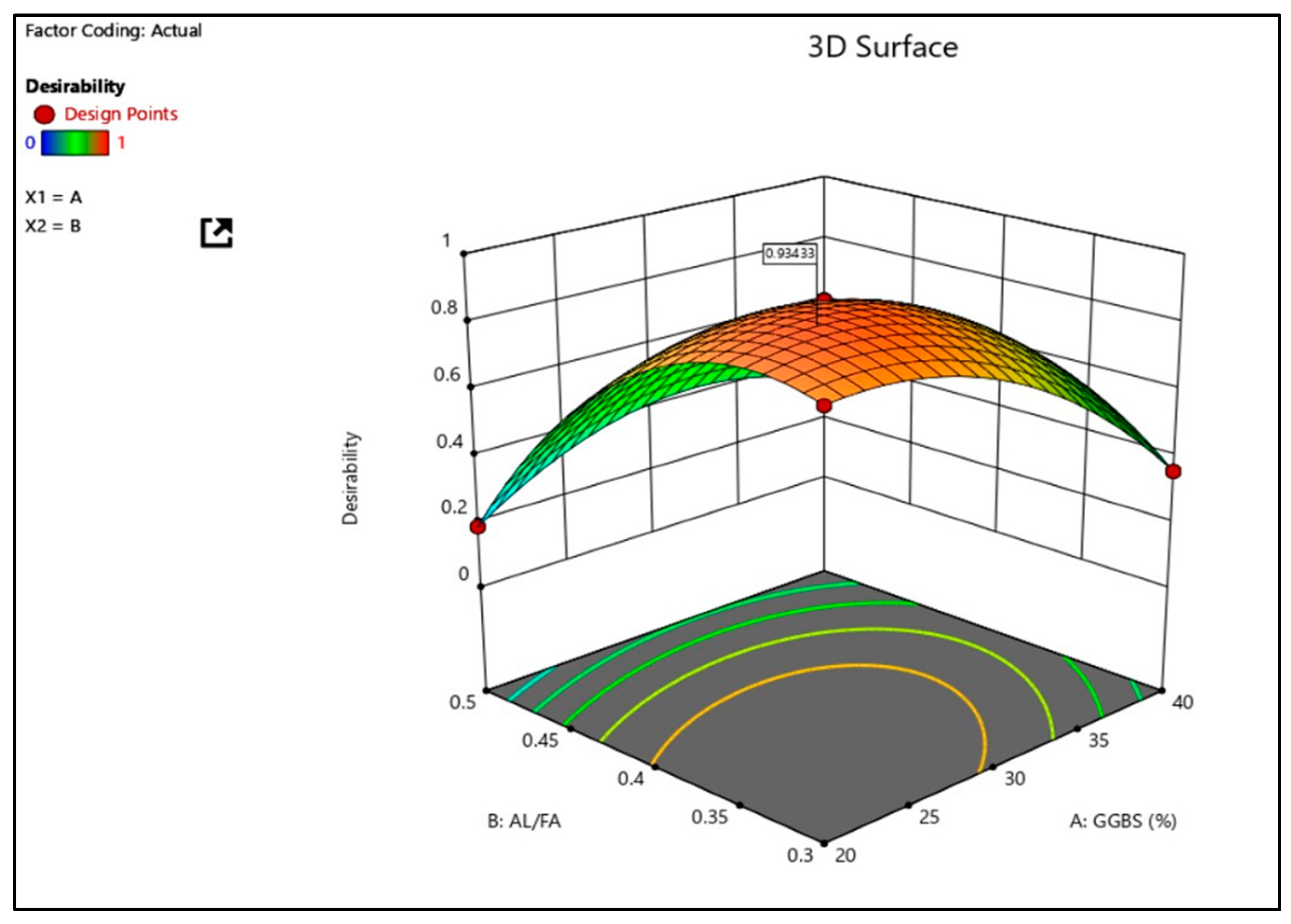




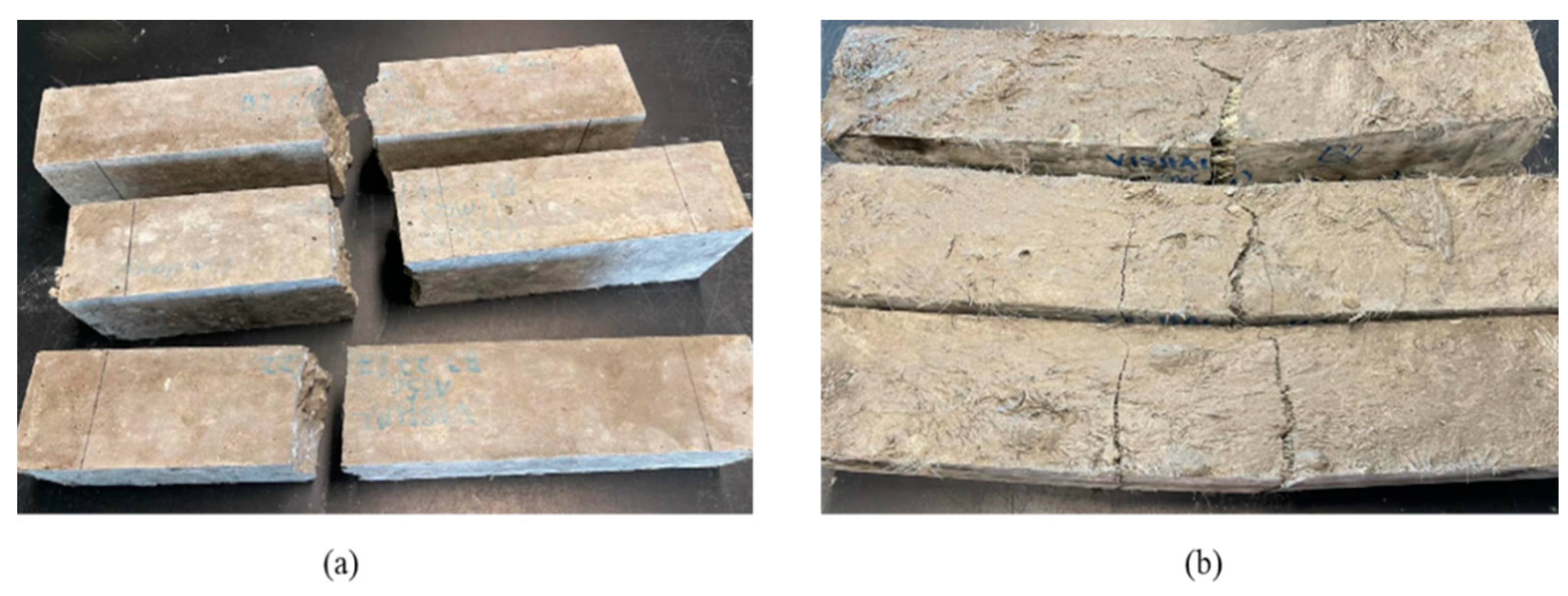
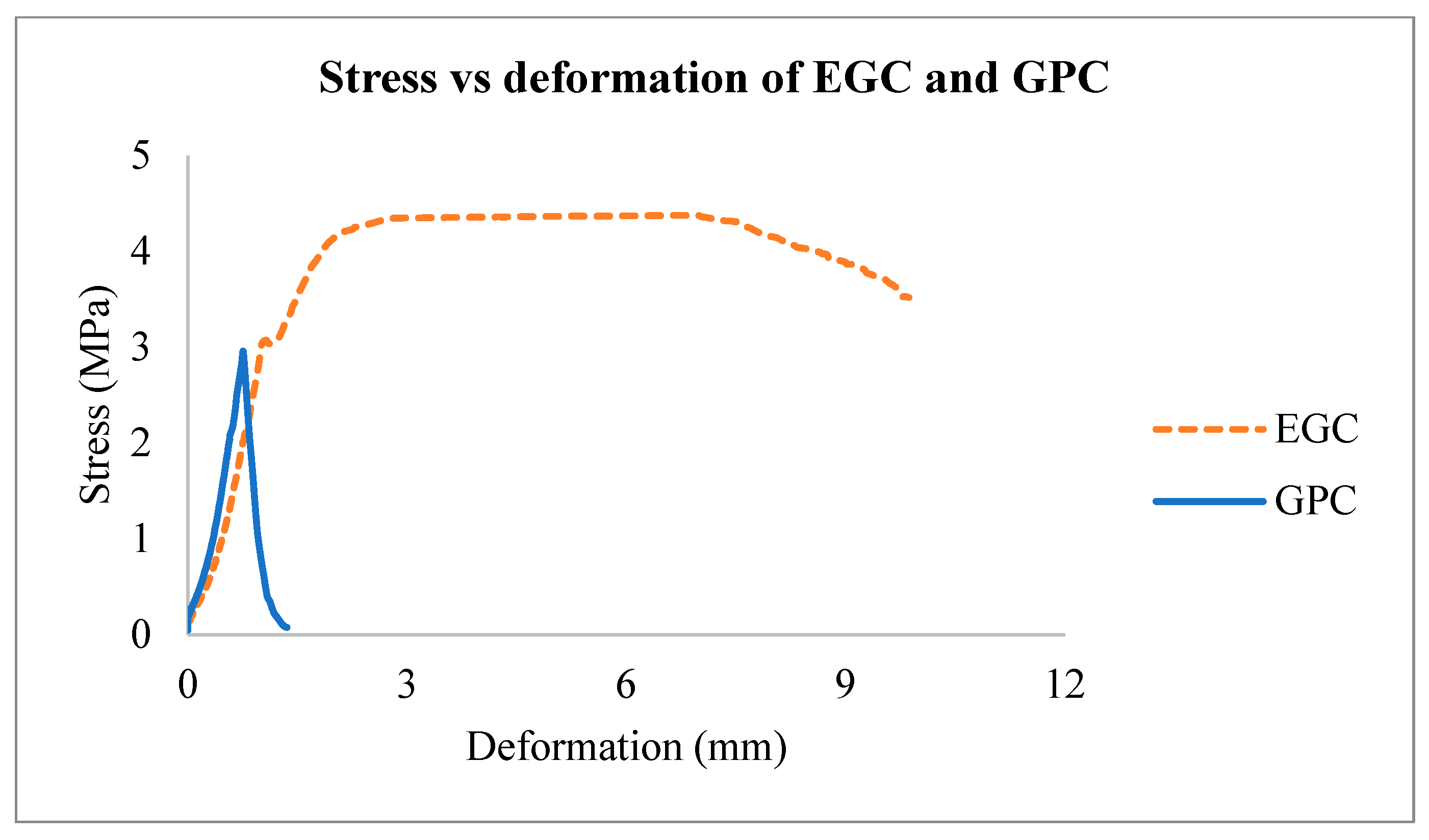

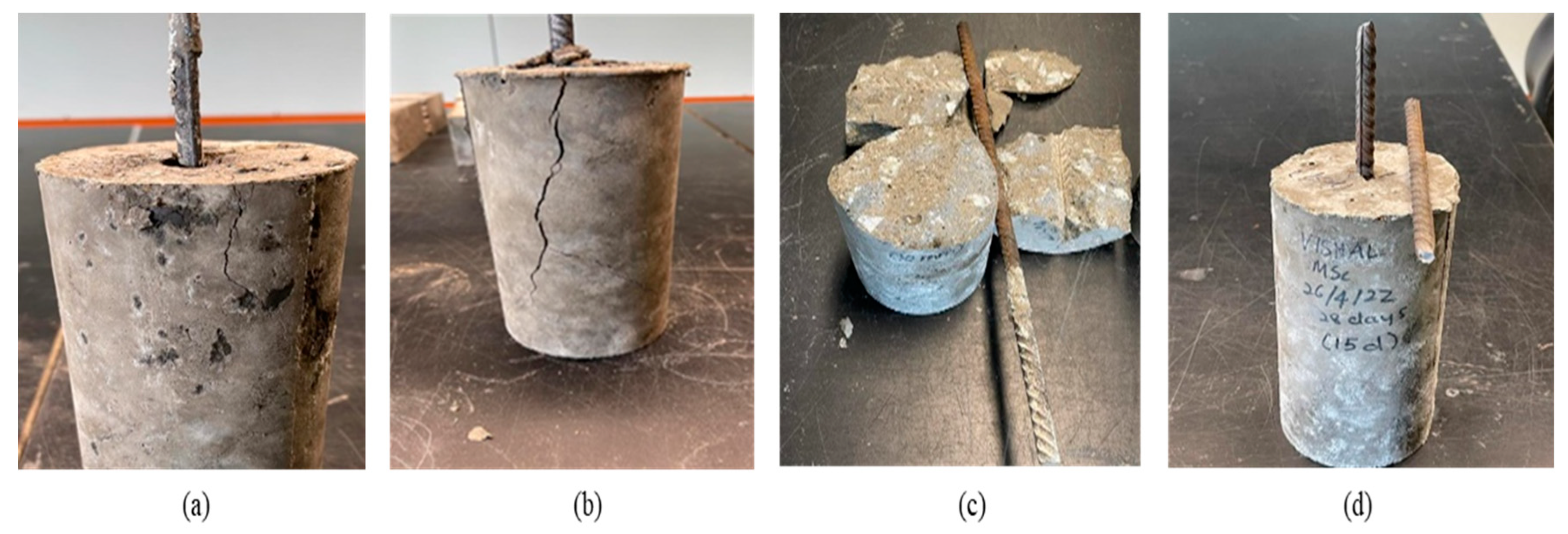
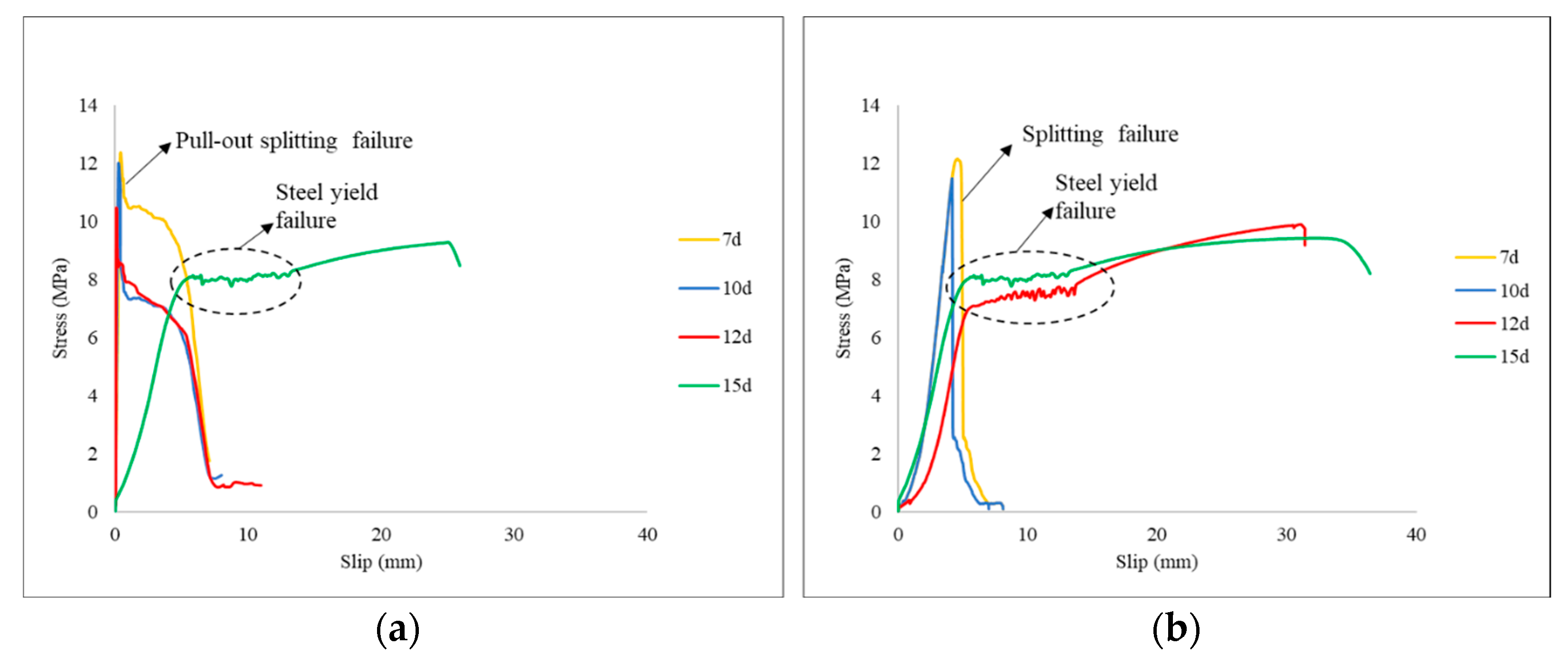
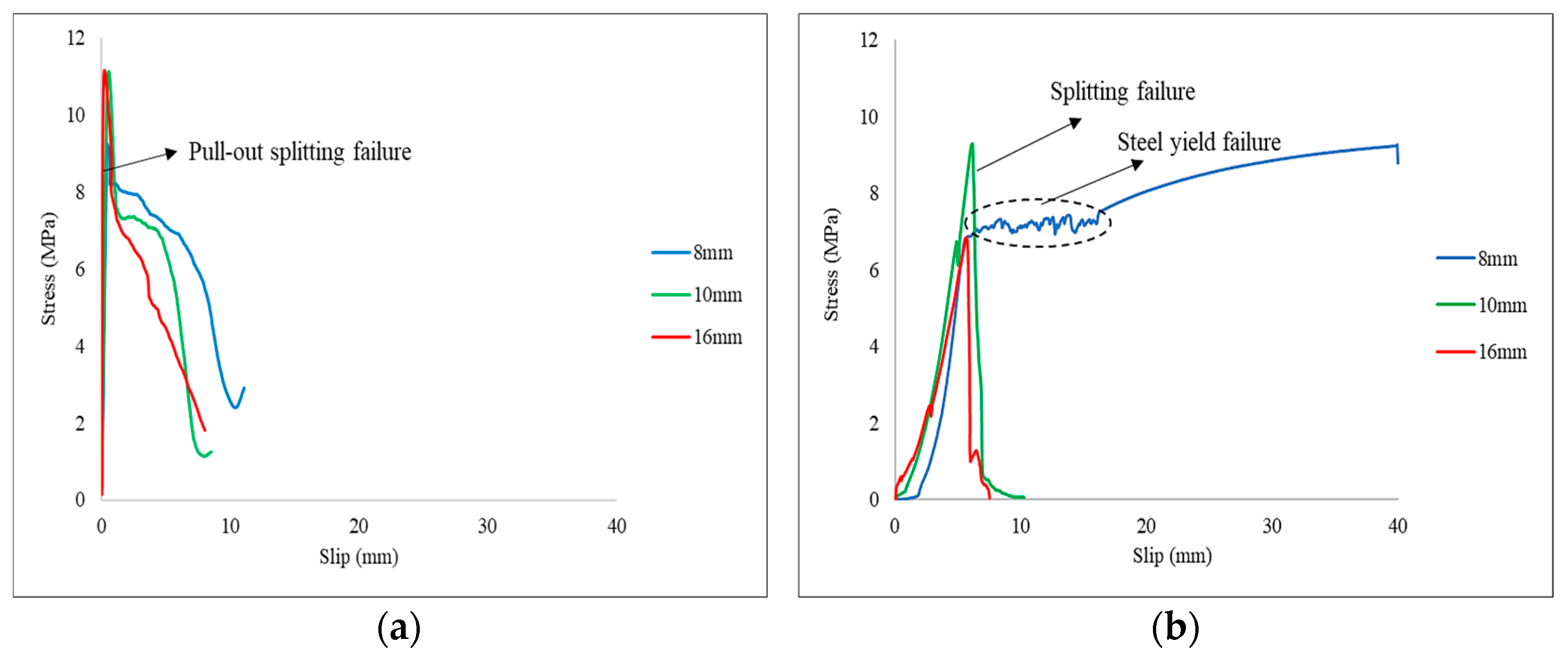
| No. | Materials |
|---|---|
| 1 | Fly ash (Type F) |
| 2 | Fine aggregate (silica sand) |
| 3 | Silica fume |
| 4 | GGBS |
| 5 | Sodium hydroxide |
| 6 | Sodium silicate |
| 7 | Polyvinyl alcohol (PVA) fibre |
| 8 | Water |
| 9 | Superplasticizer |
| Fibre | Length (mm) | Diameter (mm) | Volume (mm3) | Young’s Modulus (GPa) | Elongation (%) | Density (g/cm3) | Fibre Strength (MPa) |
|---|---|---|---|---|---|---|---|
| PVA | 18 | 0.2 | 0.57 | 27 | 9 | 1.3 | 1600 |
| Parameter | Size of Specimen (mm) | Diameter of Rebar (mm) | Embedment Length of Rebar (mm) |
|---|---|---|---|
| Embedment length | 100 × 200 | 10 | 70 (7 d) |
| 100(10 d) | |||
| 120 (12 d) | |||
| 150 (15 d) | |||
| Rebar diameter | 100 × 200 | 8 | 100 (10 d) |
| 10 | 100 (10 d) | ||
| 16 | 100 (10 d) |
| MIX ID | Silica Fume Replacement (%) | Molarity (M) | Sodium Silicate to Sodium Hydroxide Ratio |
|---|---|---|---|
| 1 | 5 | 10 | 2.5 |
| 2 | 10 | 10 | 2.5 |
| 3 | 15 | 10 | 2.5 |
| 4 | 20 | 10 | 2.5 |
| Material | kg/m³ |
|---|---|
| Fine Aggregate (Silica sand) | 330 |
| Class F Fly Ash | 880 |
| Ground granulated blast furnace slag (GGBS) | 220 |
| Silica fume | 176 |
| Sodium Hydroxide Solution (10 M) | 112 |
| Sodium Silicate Solution | 283 |
| Water | 88 |
| Polyvinyl Alcohol fibre (PVA) | 26 |
| Superplasticizer | 17.6 |
| Material | kg/m³ |
|---|---|
| Coarse aggregates | 1092 |
| Fine Aggregate (Silica sand) | 588 |
| Class F Fly Ash | 440 |
| Sodium Hydroxide Solution (10 M) | 90 |
| Sodium Silicate Solution | 180 |
| Standard | Run | Factor 1: A: GGBS% | Factor 2: B:AL/FA | Response 1: CS (MPa) |
|---|---|---|---|---|
| 5 | 1 | 15.8579 | 0.4 | 46.48 |
| 9 | 2 | 30 | 0.4 | 59.89 |
| 1 | 3 | 20 | 0.3 | 53.5 |
| 8 | 4 | 30 | 0.541421 | 17.29 |
| 6 | 5 | 44.1421 | 0.4 | 30.11 |
| 2 | 6 | 40 | 0.3 | 35.42 |
| 3 | 7 | 20 | 0.5 | 26.29 |
| 13 | 8 | 30 | 0.4 | 53.35 |
| 7 | 9 | 30 | 0.258579 | 41.33 |
| 4 | 10 | 40 | 0.5 | 35.83 |
| 12 | 11 | 30 | 0.4 | 55.74 |
| 10 | 12 | 30 | 0.4 | 52.71 |
| 11 | 13 | 30 | 0.4 | 49.19 |
| Parameters | CS |
|---|---|
| Std. Dev. | 4.26 |
| Mean | 42.86 |
| C.V. % | 9.95 |
| R2 | 0.9372 |
| PRESS | 556.65 |
| −2 Log Likelihood | 66.55 |
| Adjusted R2 | 0.8924 |
| Predicted R2 | 0.7254 |
| Adeq. Precision | 11.6356 |
| BIC | 81.94 |
| AICc | 92.55 |
| Response | Source | Sum of Squares | df | Mean Square | F-Value | p-Value |
|---|---|---|---|---|---|---|
| 1900.16 | 5 | 380.03 | 20.9 | 0.0004 | ||
| A-GGBS | 125.54 | 1 | 125.54 | 6.9 | 0.034 | |
| B-AL/FA | 462.04 | 1 | 462.04 | 25.41 | 0.0015 | |
| Compressive Strength (Mpa) | AB | 190.72 | 1 | 190.72 | 10.49 | 0.0143 |
| A2 | 336.13 | 1 | 336.13 | 18.49 | 0.0036 | |
| B2 | 911 | 1 | 911 | 50.11 | 0.0002 | |
| Residual | 127.27 | 7 | 18.18 | |||
| Lack of Fit | 64.48 | 3 | 21.49 | 1.37 | 0.3725 | |
| Pure Error | 62.79 | 4 | 15.7 | |||
| Cor Total | 2027.43 | 12 |
| Factors | A: GGBS | B:AL/FA | CS | |
|---|---|---|---|---|
| Value | minimum | 20 | 0.3 | 17.29 |
| maximum | 40 | 0.5 | 59.89 | |
| Goal | in range | in range | maximize | |
| Optimisation results | 24.71 | 0.351 | 57.092 | |
| Desirability | 0.934 (93%) | |||
| Response | Predicted | Experimental | Error |
|---|---|---|---|
| CS (MPa) | 57.092 | 58.235 | 2% |
| MIX ID | Silica Fume Replacement (%) | 1st Day Compressive Strength (MPa) | 7th Day Compressive Strength (MPa) | 14th Day Compressive Strength of (MPa) | 28th Day Compressive Strength of (MPa) |
|---|---|---|---|---|---|
| 1 | 5 | 5.7 | 8.4 | 19.66 | 30.67 |
| 2 | 10 | 6.58 | 18 | 22 | 39.2 |
| 3 | 15 | 9.22 | 22.18 | 37.28 | 40.29 |
| 4 | 20 | 12.58 | 46.42 | 47.45 | 60 |
| MIX ID | 1st Day Compressive Strength (MPa) | 7th Day Compressive Strength (MPa) | 14th Day Compressive Strength of (MPa) | 28th Day Compressive Strength of (MPa) |
|---|---|---|---|---|
| 1 | 5 | 27.26 | 45.62 | 58.8 |
| Age Days | Flexural Strength of EGC (MPa) | Average Strength (MPa) | Failure Displacement (mm) | Yielding Displacement (mm) | Ductility (mm) | Compressive Strength (MPa) | Tensile Strength (MPa) |
|---|---|---|---|---|---|---|---|
| 28 | 6.031 | 5.575 | 4 | 1 | 4 | 60 | 4.003 |
| 5.325 | 3 | 1 | 3 | ||||
| 5.368 | 3 | 1 | 3 |
| Age Days | Flexural Strength of GPC (MPa) | Average Strength (MPa) | Failure Displacement (mm) | Yielding Displacement (mm) | Ductility (mm) | Compressive Strength (MPa) | Tensile Strength (MPa) |
|---|---|---|---|---|---|---|---|
| 28 | 4.948 | 5.137 | 0.8 | 0.6 | 1.3 | 58.8 | 1.6 |
| 5.395 | 1.1 | 0.92 | 1.2 | ||||
| 5.067 | 1.35 | 1.1 | 1.2 |
| No. | Bar Diameter (mm) | Embedded Length (mm) | Bond Strength of EGC (MPa) | Bond Strength of GPC (MPa) |
|---|---|---|---|---|
| 1 | 8 | 100 | 9.22 | 9.10 |
| 2 | 10 | 10.86 | 9.29 | |
| 3 | 16 | 10.96 | 6.85 |
| No. | Bar Diameter (mm) | Embedment Length (mm) | Bond Strength of EGC (MPa) | Bond Strength of GPC (MPa) |
|---|---|---|---|---|
| 1 | 10 | 70 | 12.27 | 12.13 |
| 2 | 100 | 11.92 | 11.47 | |
| 3 | 120 | 10.45 | 9.47 | |
| 4 | 150 | 9.41 | 7.43 |
| Bond Failure Modes | ||
|---|---|---|
| Parameters | EGC | GPC |
| 28 Days | 28 Days | |
| Rebar diameter | ||
| 8 mm | P-O | Y |
| 10 mm | P-S | S |
| 16 mm | P-S | S |
| Embedment length | ||
| 7 D | P-O | S |
| 10 D | P-S | S-S |
| 12 D | P-S | Y |
| 15 D | Y | Y |
Disclaimer/Publisher’s Note: The statements, opinions and data contained in all publications are solely those of the individual author(s) and contributor(s) and not of MDPI and/or the editor(s). MDPI and/or the editor(s) disclaim responsibility for any injury to people or property resulting from any ideas, methods, instructions or products referred to in the content. |
© 2023 by the authors. Licensee MDPI, Basel, Switzerland. This article is an open access article distributed under the terms and conditions of the Creative Commons Attribution (CC BY) license (https://creativecommons.org/licenses/by/4.0/).
Share and Cite
Ramesh, V.A.; Nikbakht Jarghouyeh, E.; Alraeeini, A.S.; Al-Fakih, A. Optimisation Investigation and Bond-Slip Behaviour of High Strength PVA-Engineered Geopolymer Composite (EGC) Cured in Ambient Temperatures. Buildings 2023, 13, 3020. https://doi.org/10.3390/buildings13123020
Ramesh VA, Nikbakht Jarghouyeh E, Alraeeini AS, Al-Fakih A. Optimisation Investigation and Bond-Slip Behaviour of High Strength PVA-Engineered Geopolymer Composite (EGC) Cured in Ambient Temperatures. Buildings. 2023; 13(12):3020. https://doi.org/10.3390/buildings13123020
Chicago/Turabian StyleRamesh, Vishal Avinash, Ehsan Nikbakht Jarghouyeh, Ahmed Saleh Alraeeini, and Amin Al-Fakih. 2023. "Optimisation Investigation and Bond-Slip Behaviour of High Strength PVA-Engineered Geopolymer Composite (EGC) Cured in Ambient Temperatures" Buildings 13, no. 12: 3020. https://doi.org/10.3390/buildings13123020






